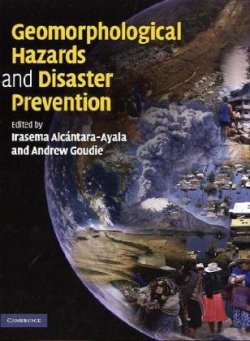
This book is advertised as being “accessible to geomorphologists and Earth scientists involved in environmental science, hazard and risk assessment, management and policy”: thus, aimed at specialists rather than generalist hazard and risk managers. Although it is intended to examine “what hazard and risk managers want from geomorphologists and what geomorphologists believe they can offer to them”, all of the authors seem to be geomorphologists. It would have been interesting if at least a few contributions had been invited from “managers”.
The volume has two main sections – firstly, “processes” and, secondly, “processes and applications of geomorphology to risk assessment” containing 16 and 7 papers respectively. Papers in Part 1 range from the specific to the general, giving an uneven depth of coverage. One paper focuses on lichenometry for dating landside episodes while another considers all mountain hazards in general. In Part 2, papers range from the practical (e.g. use of GIS for the assessment of flood and landslide risk) to historical and philosophical discussion of vulnerability analysis as a part of geomorphological risk assessment. Disappointingly, the paper devoted to the requirements of risk managers and what geomorphology has to offer them is almost entirely devoted to the latter. The concluding section takes the line that while the terms “natural, geomorphological, geophysical and hydrometeorological are widely used, the concept of geomorphological hazard is.....rather unknown”. While appreciation of hazard management has made significant progress in many areas, more does need to be done. One wonders whether a text aimed at non-specialists would have been more effective in advancing understanding.
The book deals fairly comprehensively with hazards (seismic, volcanic, flooding, desertification and dune migration, slope instability and avalanche, weathering, dissolution, subsidence and erosion) in a wide range of physical and climatic environments. However it is somewhat weak on hazards in glacial and periglacial environments. Some sections are devoted to environments while others focus on specific hazards. The reader has therefore to refer between sections to develop a full picture. Most of the contributions focus on hazards and, to some extent, investigation and mitigation of these. But only a few consider vulnerability (7 out of 23) and risk (3) in any detail.
The book is well presented, similar in quality to the Special Publications series of the Society. A few of the photographs are poorly reproduced, but that does not detract significantly. Despite some unevenness in content it is well worth reading and is relatively cheap as technical books go.
Reviewed by Brian Marker
GEOMORPHOLOGICAL HAZARDS AND DISASTER PREVENTION
IRASEMA ALCÁNTARA-AYALA AND ANDREW GOUDIE (editors) Published by: Cambridge University Press; Publication date: March, 2010; ISBN: 978-0-521-76925-9 (hbk) 304 pp List price: £45.00. www.cambridge.org